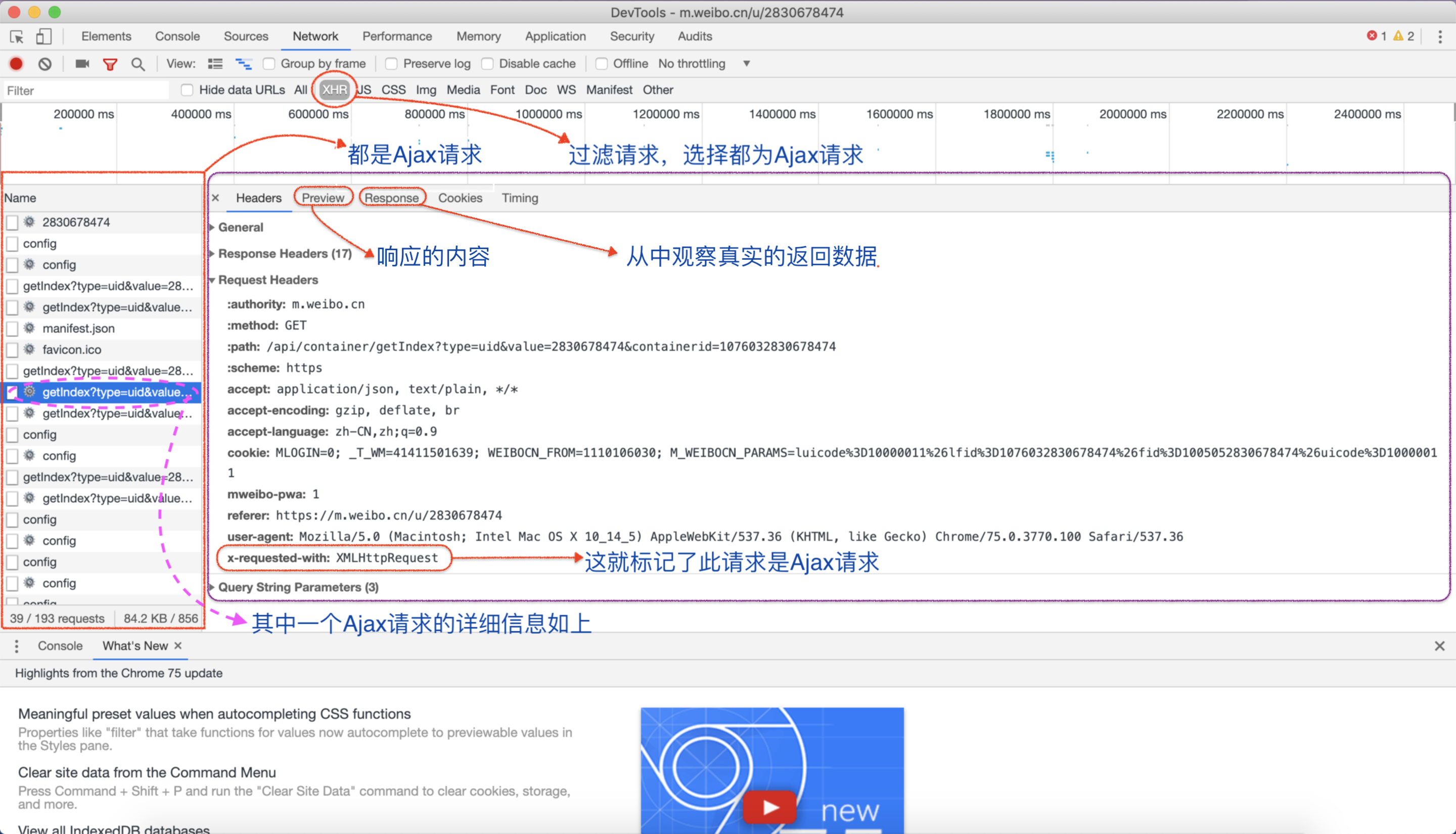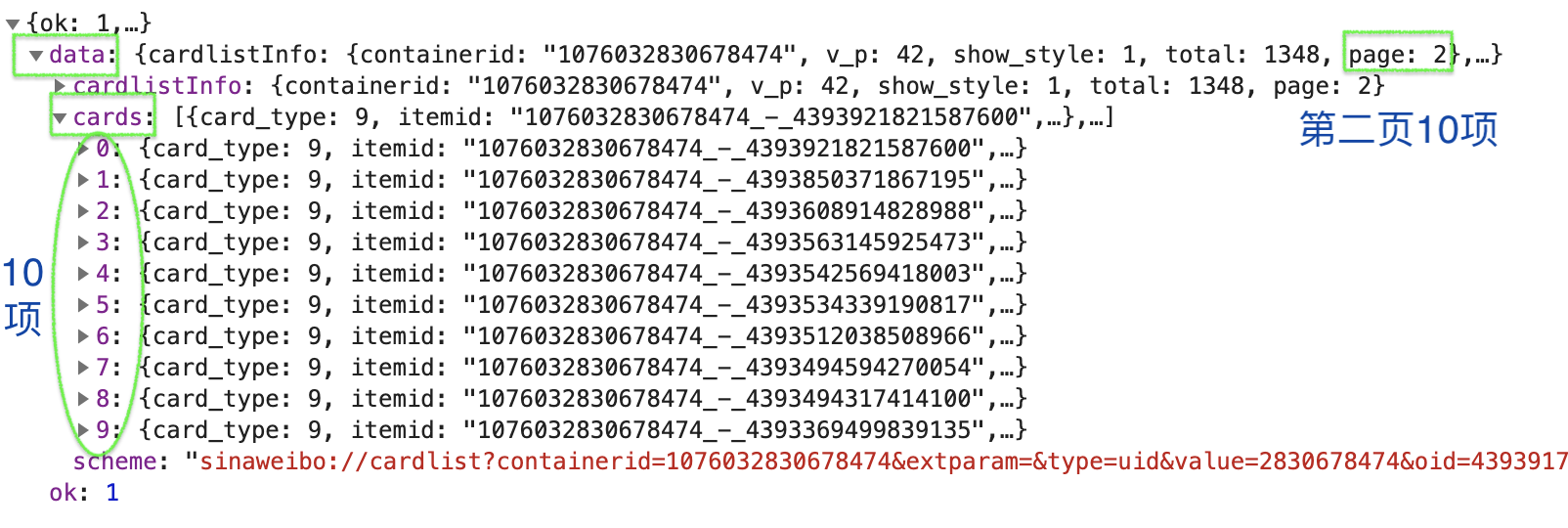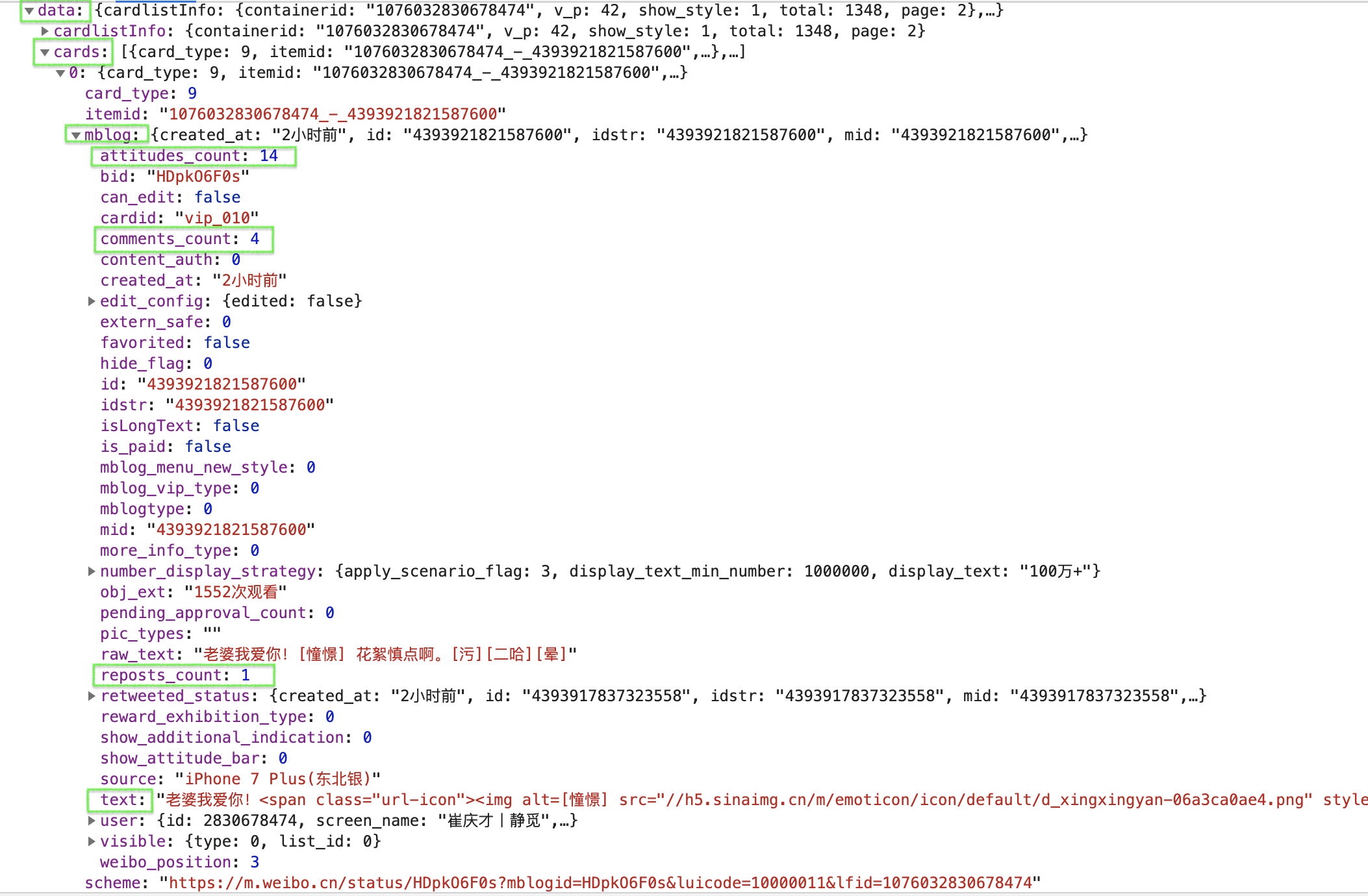Python 网络爬虫之 Ajax 数据爬取
Ajax 概述
Ajax是利用 JavaScript在保证页面不被刷新、页面链接不改变的情况下与服务器交换数据并更新部分网页的技术。
Ajax基本原理
- 发送请求
- 解析内容
- 渲染页面
查看请求

Ajax结果提取
爬取一个人微博的前面10页
分析过程




Python代码实现
复制from urllib.parse import urlencode import requests # 对https://m.weibo.cn/u/2830678474网页审查分析 base_url = 'https://m.weibo.cn/api/container/getIndex?' headers = { 'Host': 'm.weibo.cn', 'Referer': 'https://m.weibo.cn/u/2830678474', 'User-Agent': 'Mozilla/5.0 (Macintosh; Intel Mac OS X 10_14_5) AppleWebKit/537.36 (KHTML, like Gecko) ' 'Chrome/75.0.3770.100 Safari/537.36', 'X-Requested-With': 'XMLHttpRequest' } # page 为页码,返回每一页响应的JSON编码内容(如果有) def get_page(page): params = { 'type': 'uid', 'value': '2830678474', 'containerid': '1076032830678474', 'page': page } url = base_url + urlencode(params) try: response = requests.get(url, headers=headers) if response.status_code == 200: # response.status_code获取网页状态码 return response.json() # response.json()返回响应的JSON编码内容 except requests.ConnectionError as e: # 出现异常,捕获并输出其异常信息 print('Error:', e.args) from pyquery import PyQuery # 根据获取的json编码,筛选出我们需要的内容 def parse_page(json): if json: items = json.get('data').get('cards') # 获取json编码中的data里面的cards的内容,返回结果是一个迭代器 for item in items: # 遍历每条cards内容 item = item.get('mblog') # 获取mblog中的内容 weibo = {} weibo['id'] = item.get('id') # 获取'id'内容 weibo['text'] = PyQuery(item.get('text')).text() # 利用get()获取'text'内容,再利用PyQuery()方法初始化Json编码形式,再利用text()获取子节点的文本表示形式。 weibo['attitudes'] = item.get('attitudes_count') # 获取'赞'的个数 weibo['comments'] = item.get('comments_count') # 获取'评论'数 weibo['reposts'] = item.get('reposts_count') # 获取'分享'次数 yield weibo from pymongo import MongoClient client = MongoClient() # 连接MongoDB db = client['weibo'] # 指定weibi数据库 collection = db['weibo'] # 指定weibo集合 # 将数据插入Mongo数据库 def save_to_mongo(result): if result: collection.insert_one(result) # 调用insert_one()方法,将一条数据插入到数据库中 print('Saved to Mongo') if __name__ == '__main__': for page in range(1, 11): # 获取10页 json = get_page(page) results = parse_page(json) for result in results: print(result) save_to_mongo(result)
结果
-
部分输出
复制{'id': '4393921821587600', 'text': '老婆我爱你! 花絮慎点啊。', 'attitudes': 16, 'comments': 4, 'reposts': 1} Saved to Mongo {'id': '4393850371867195', 'text': '执行力非常重要,做一个实干者。', 'attitudes': 1, 'comments': 0, 'reposts': 3} Saved to Mongo {'id': '4393608914828988', 'text': '欧耶!!!!!@长泽牙妹\n济南', 'attitudes': 9, 'comments': 15, 'reposts': 0} Saved to Mongo {'id': '4393563145925473', 'text': '叔叔要和我喝酒了。\n我好慌。 济南', 'attitudes': 10, 'comments': 20, 'reposts': 0} Saved to Mongo -
MongoDB数据库查看数据

异步(Ajax)爬取今日头条街拍美图
类似上面爬微博的方法,爬取今日头条街拍美图
复制import requests from urllib.parse import urlencode base_url = 'https://www.toutiao.com/api/search/content/?' headers = { 'Host': 'www.toutiao.com', 'Referer': 'https://www.toutiao.com/search/?keyword=%E8%A1%97%E6%8B%8D', 'User-Agent': 'Mozilla/5.0 (Macintosh; Intel Mac OS X 10_14_5) AppleWebKit/537.36 (KHTML, like Gecko) ' 'Chrome/75.0.3770.100 Safari/537.36', 'X-Requested-With': 'XMLHttpRequest' } # 一个关于offset和timestamp数据的列表 def offset_timestamp(): offsets = [offset for offset in range(8)] timestamps = [1563094062541, 1563094066268, 1563094068231, 1563094069948, 1563094071549, 1563094073370, 1563094075154, 1563094077384] tuple_list = [] for i in range(8): tuple_list.append( (offsets[i], timestamps[i]) ) return tuple_list # 获取页面Json编码 def get_page(tuple_): params = { 'aid': '24', 'app_name': 'web_search', 'offset': tuple_[0], 'format': 'json', 'keyword': '%E8%A1%97%E6%8B%8D', 'autoload': 'true', 'count': '20', 'en_qc': '1', 'cur_tab': '1', 'from': 'search_tab', 'pd': 'synthesis', 'timestamp': tuple_[1] } url = base_url + urlencode(params) try: response = requests.get(url, headers) if response.status_code == 200: return response.json() except requests.ConnectionError as e: print('Error:', e.args) return None # 获取图片URL def get_images(json): if json.get('data'): data = json.get('data') if data.get('abstract'): for item in data.get('data'): abstract = item.get('abstract') images = item.get('image_list') for image in images: yield { 'image': image.get('url'), 'abstract': abstract } import os from hashlib import md5 # 保存图片 def save_image(item): if not os.path.exists(item.get('abstract')): # os.path.exists(path)方法,测试路径是否存在 os.mkdir(item.get('abstract')) # os.mkdir()方法,创建一个目录 try: response = requests.get(item.get('image')) # 对获取的image_URL发送请求 if response.status_code == 200: file_path = '{0}/{1}.{2}'.format(item.get('abstract'), md5(response.content).hexdigest(), 'jpg') # 图片的名称可以使用MD5值,这样可以去除重复。 # response.content属性返回响应内容。 # hexdigest()方法,以十六进制数字的字符串形式返回摘要值。 if not os.path.exists(file_path): with open(file_path, 'wb') as f: f.write(response.content) # 将响应的内容以二进制的形式写入文件file_path中 else: print('Already Downloaded', file_path) except requests.ConnectionError as e: print( 'Error:', e.args, '\nFailed to Save Image' ) if __name__ == '__main__': tuple_list = offset_timestamp() for tuple_ in tuple_list: json = get_page(tuple_) for item in get_images(json): print(item) save_image(item)
本文来自博客园,作者:LeeHua,转载请注明原文链接:https://www.cnblogs.com/liyihua/p/11182862.html




【推荐】国内首个AI IDE,深度理解中文开发场景,立即下载体验Trae
【推荐】编程新体验,更懂你的AI,立即体验豆包MarsCode编程助手
【推荐】抖音旗下AI助手豆包,你的智能百科全书,全免费不限次数
【推荐】轻量又高性能的 SSH 工具 IShell:AI 加持,快人一步
· AI与.NET技术实操系列:向量存储与相似性搜索在 .NET 中的实现
· 基于Microsoft.Extensions.AI核心库实现RAG应用
· Linux系列:如何用heaptrack跟踪.NET程序的非托管内存泄露
· 开发者必知的日志记录最佳实践
· SQL Server 2025 AI相关能力初探
· 震惊!C++程序真的从main开始吗?99%的程序员都答错了
· winform 绘制太阳,地球,月球 运作规律
· 【硬核科普】Trae如何「偷看」你的代码?零基础破解AI编程运行原理
· 超详细:普通电脑也行Windows部署deepseek R1训练数据并当服务器共享给他人
· 上周热点回顾(3.3-3.9)